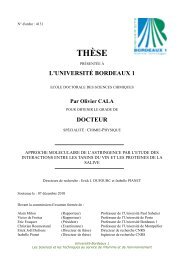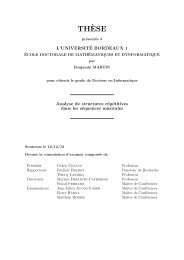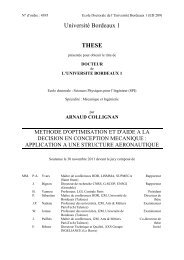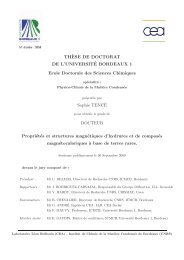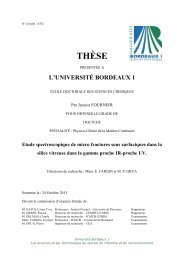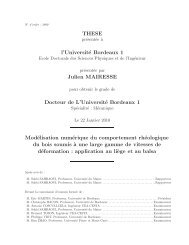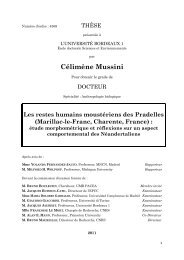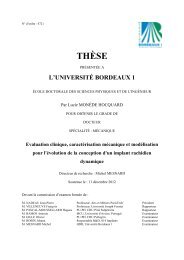de la structure à la croissance cellulaire - Université Bordeaux 1
de la structure à la croissance cellulaire - Université Bordeaux 1
de la structure à la croissance cellulaire - Université Bordeaux 1
You also want an ePaper? Increase the reach of your titles
YUMPU automatically turns print PDFs into web optimized ePapers that Google loves.
110 M. Bourdon et al.<br />
syncitial female gametophyte (Ya<strong>de</strong>gari and Drews 2004), in anther tapetum<br />
(D’Amato 1984) and seed endosperm (Berger 2003), while nuclear fusion may<br />
also contribute to polyploidization of the cha<strong>la</strong>zal domain of the endosperm in<br />
Arabidopsis (Baroux et al. 2004). Endomitosis corresponds to a doubling of the<br />
chromosome number in nucleus. Chromosomes double and con<strong>de</strong>nse, sister chromatids<br />
separate normally, but return to the interphase state within an intact nuclear<br />
envelope, thus generating nuclear endopolyploidy. Although endomitosis mainly<br />
occurrs in animals, it is only rarely encountered in p<strong>la</strong>nts (D’Amato 1984).<br />
Endoreduplication represents the most common mo<strong>de</strong> of cell endopolyploidization<br />
in p<strong>la</strong>nts and is estimated to occur in over 90% of Angiosperms (Nagl 1976; D’Amato<br />
1984). This process is an endonuclear chromosome duplication, which occurs in the<br />
absence of any obvious con<strong>de</strong>nsation and <strong>de</strong>con<strong>de</strong>nsation steps leading to the production<br />
of chromosomes with 2n chromatids without any change in chromosome number<br />
(Joubès and Chevalier 2000; Edgar and Orr-Weaver 2001). As a consequence,<br />
hypertrophying nuclei arise from successive cycles of DNA replication without<br />
segregation of sister chromatids, and in extreme cases “giant” polytene chromosomes<br />
are generated as observed for embryo suspensor cells of Phaseolus species (D’Amato<br />
1984) or giant hair cells of Bryonia anthers (Barlow 1975).<br />
3.2 Occurrence of Endopolyploidization in Fruit Species<br />
As stated by D’Amato (1984), endopolyploidy is “of such a wi<strong>de</strong>spread occurrence<br />
in p<strong>la</strong>nts, that it can be regar<strong>de</strong>d as the rule rather than the exception.” A recent<br />
survey performed on several vegetative organs of 54 seed p<strong>la</strong>nt species different in<br />
term of genome size and belonging to two Gymnosperm and 14 Angiosperm<br />
families by Barow and Meister (2003) indicated that endopolyploidy occurred in<br />
33 species taken from ten different families. Though absent in Gymnosperms,<br />
the frequent occurrence of endopolyploidy within Angiosperms seems restricted,<br />
however, to certain phylogenetic groups (Barow 2006).<br />
Though <strong>la</strong>rgely documented in vegetative organs (Barow and Meister 2003), the<br />
occurrence of endopolyploidy in reproductive organs, especially in fruit tissues, and<br />
its extent in different species has gained little attention so far. Endopolyploidization<br />
was found in ovu<strong>la</strong>r tissues (antipodal cells, synergids, endosperm and embryo<br />
suspensor cells) and in anther cells (anther hair, g<strong>la</strong>ndu<strong>la</strong>r hair and anther tapetal<br />
cells), where endoreduplication seems to be the preferential way of polyploidization<br />
(D’Amato 1984; Carvalheira 2000; Bauer and Birchler 2006).<br />
More than 60 years ago, endopolyploidization was reported initially in cucumber<br />
and other fruit materials (cited in Coombe 1976 and Barow 2006) and then in the<br />
mesocarp parenchyma cells in apricot (Bradley and Crane 1955). However, in this<br />
<strong>la</strong>tter report the natural and/or physiological occurrence of the phenomenon in this<br />
fruit could be questioned as these authors observed polysomaty (increase in chromosome<br />
number according to endomitosis), after an auxin treatment and subsequent



